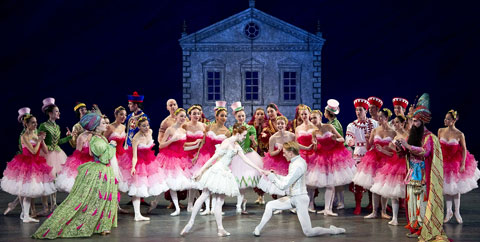
DREAM AND REALITY In Ratmansky’s choreography, the Sugar Plum Fairy is Clara’s vision of her grown-up self. |
NEW YORK — The greatness of Alexei Ratmansky's new Nutcracker, which American Ballet Theatre premiered on December 23 at Brooklyn Academy's Opera House, lies in two famous scenes, both recognizable yet reconceived and reanimated by the choreographer. The snow scene and the grand pas de deux are usually staged as climactic showpieces for acts one and two, in this most familiar of the old Russian ballets. With characteristic humanism, Ratmansky makes them something more.
The Nutcracker, universally beloved as it is, presents dramatic flaws and loose ends. The first act is essentially a story; the second is a string of specialty dances. The principal characters in the story don't do classical dancing, and the dancers in the divertissements have no narrative role. Children occupy the center of the plot, but grown-ups are the dancing stars. Drosselmeyer, the benevolent but mysterious uncle, fades out of the picture as soon as the fairy-tale action begins.
.jpg)
Clara (Gillian Murphy) and Nutcracker (David Hallberg) perform the pas de deux |
Ratmansky reconciles the most crucial of these contradictions by making the virtuoso Sugar Plum Fairy into Clara's vision of her grown-up self. Clara's dream journey to the Kingdom of the Sweets is usually interpreted as an escape from her apprehension about growing up, as an expression of her sexual wish fulfillment or panic. In Ratmansky's version, Clara's fear stems from external events — the mice that invade the kitchen, the cold of a snowy night. But she's rescued by love, and by confidence in her own future.
What Ratmansky does so remarkably well is to embed the temperament, the secrets, the vulnerability, and the sociability of his characters within the dance action. Lingering after the party, two maids gossip together and imitate the grandmother's tottery little jig. The children at the party — an ensemble of 16 youngsters coached by Johanna Butow and Kate Lydon — stamp their feet and demand their presents, but they calm down and behave beautifully when summoned for their dance.
The worlds of dream and reality overlap and alternate from the moment Clara receives Drosselmeyer's gift of a nutcracker. In her imagination, it turns into a boy. (Catherine Hurlin, 14, and Tyler Maloney, 13, played these parts marvelously on opening night.) After the party, after she helps defeat the Mouse King in battle, Clara and the Nutcracker wander outside into the snow. At first, they're overcome with wonder. They scamper around and begin waltzing together. Their dance is shadowed by their grown-up selves, a magical couple in white ballet costumes. Clara might be dreaming about love and romance, or maybe she's picturing herself as a beautiful ballerina.
When the dancing Snowflakes appear, Clara and the Nutcracker romp among them, cold but still delighted to join in their formal patterns. It gets darker — Jennifer Tipton's lighting replicates the strange glow of a real snowstorm at night. The Snowflakes swirl around the children and grow threatening, but Drosselmeyer arrives with a sleigh and a blanket to wrap them deeper into their dream. The Snowflakes lie down one by one, blanketing the ground.